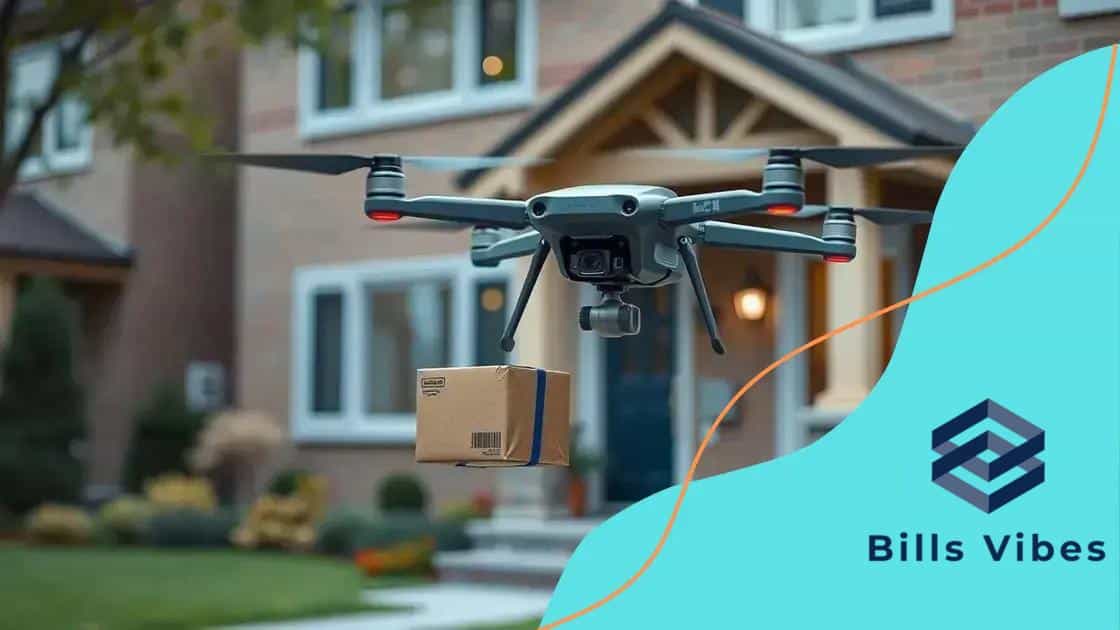Drones in delivery services: transforming logistics fast

Drones in delivery services enhance logistics by providing faster delivery times, reducing costs, and increasing efficiency, while facing challenges such as regulatory hurdles and safety concerns.
Drones in delivery services are changing the game in logistics. Imagine receiving your package within minutes, thanks to aerial technology. Curious about how this works? Let’s dive in.
Benefits of using drones in delivery
The use of drones in delivery services offers significant advantages that are reshaping the logistics landscape. Companies are looking for more efficient ways to get products to customers, and drones are emerging as a compelling solution.
Efficiency and Speed
One of the primary benefits of using drones is their ability to make deliveries faster than traditional vehicles. Drones can bypass traffic and travel directly to their destination, which reduces the time customers wait for their orders.
Cost-Effectiveness
In the long run, employing drone technology can lower operational costs. While the initial investment may be high, the savings in fuel and labor can make drones a more economical option.
- Fewer labor hours needed for deliveries
- Reduced fuel consumption
- Lower maintenance costs compared to delivery trucks
The flexibility of drone operations also adds to their appeal, as they can easily adapt to varying delivery schedules and routes. As technology advances, drones can be programmed to choose the most efficient paths autonomously.
Environmental Impact
Drones have a smaller carbon footprint than traditional delivery methods. They contribute less pollution, making them a greener alternative in the industry. As consumers become more environmentally conscious, companies that adopt eco-friendly delivery solutions can attract more customers.
In conclusion, the benefits of using drones in delivery services are clear. Their efficiency, cost-effectiveness, and positive environmental impact make them an important asset for the future of logistics.
How drones enhance delivery efficiency
Drones significantly enhance delivery efficiency in various ways that transform traditional logistics. By leveraging advanced technology, they streamline the delivery process and reduce operational delays.
Direct Flight Paths
One advantage of drones is their ability to fly directly to their destination, unlike vehicles that are often stuck in traffic. This direct routing not only speeds up deliveries but also allows for better planning and resource allocation.
Automated Delivery Systems
Incorporating automated systems into drone delivery reduces the need for human intervention. Drones can be programmed to execute deliveries autonomously, ensuring accuracy and minimizing errors.
- Real-time navigation to avoid obstacles
- Scheduled deliveries based on customer demand
- Data collection for optimizing delivery routes
The use of GPS technology allows drones to pinpoint their routes accurately. This means orders can be delivered quickly, whether it’s a single package or multiple deliveries. With improved coordination, businesses can fulfill customer needs more efficiently.
Increased Capacity
Drones can transport multiple packages at once. This capability allows companies to make fewer trips while sending more products. With this in mind, retailers can align their inventory management with delivery services, increasing overall productivity.
Moreover, the versatility of drones enables them to access remote or hard-to-reach locations easily. Customers in rural areas benefit from fast delivery times, closing the gap between urban and village logistics.
Challenges facing drone delivery services

While drones in delivery services offer many benefits, there are also significant challenges that need to be addressed. These obstacles can impact the effectiveness and widespread adoption of drone technology in logistics.
Regulatory Hurdles
One major challenge is navigating the complex landscape of regulations. Different regions have different laws regarding airspace usage and drone operations. Companies must work hard to comply with these regulations while maintaining efficient delivery services.
Safety and Security
Another concern is safety. Drones can pose risks if not operated properly, such as flying into restricted areas or malfunctioning mid-flight. Ensuring that drones are safe to operate is essential for both companies and customers.
- Need for reliable safety protocols
- Risk of collisions with other aircraft
- Potential for drone theft or vandalism
Furthermore, the privacy of individuals is a concern with drone deliveries. Consumers are increasingly aware of how their data is being used and want assurances that their privacy is respected when utilizing drone services.
Technical Limitations
Despite advancements, drones still face technical limitations, such as battery life and payload capacity. Many drones can only carry a limited amount of weight, which restricts the types of products they can deliver.
Moreover, issues with weather conditions can impact flight operations. Heavy rain, strong winds, or snow can limit a drone’s ability to perform deliveries. As drone technology evolves, addressing these challenges will be crucial to unlocking its full potential.
Regulations surrounding drone operations
The regulations surrounding drone operations are essential for ensuring safety and efficiency in delivery services. As drones become more popular, governments are working on creating rules that guide their use.
Federal Aviation Administration (FAA) Guidelines
In the United States, the FAA has established important guidelines for drone operations. These rules help to protect airspace and promote safe flying practices.
- Drones must be registered with the FAA.
- Operators must follow altitude limits.
- Night flying is generally restricted unless approved.
These measures aim to prevent accidents and ensure that all air traffic remains safe. Companies looking to implement drone delivery services must familiarize themselves with these regulations to avoid penalties.
Local and State Laws
In addition to federal regulations, local and state laws may also impact drone operations. Different states may impose further restrictions based on their specific needs and concerns.
For example, some regions may have laws that limit where drones can fly, particularly over schools or crowded areas. Companies must know and comply with these regulations to ensure they operate legally.
Privacy Concerns
Another significant aspect of drone regulations is related to privacy. Drones equipped with cameras can raise concerns among the public about surveillance. As a result, many areas are implementing laws that restrict how and where drones can capture images.
Companies must ensure that their drone operations respect the privacy of individuals and comply with all relevant laws to build trust with customers.
Future trends in drone delivery
The future of drone delivery is exciting and filled with potential. As technology continues to advance, several trends are set to change how we think about logistics and transportation.
Increased Automation
One major trend is the rise of automation in drone operations. Companies are investing in smarter drones that can navigate autonomously. These drones will be able to make deliveries without human oversight, which will boost efficiency and reduce labor costs.
Integration with Other Technologies
Another key development is integrating drones with other technologies, such as artificial intelligence (AI) and the Internet of Things (IoT). This combination will enable drones to communicate with other devices, improving routing and tracking.
- Real-time data sharing for better deliveries
- Enhanced route planning through AI
- Increased safety due to better obstacle detection
As drones become smarter, they will be able to adapt to changes in their environment and respond to traffic conditions or delivery schedules dynamically. This adaptability will be crucial for meeting customer demands.
Urban Air Mobility
Urban air mobility is another exciting concept related to drone delivery. This idea envisions a future where drones help transport people and goods in crowded urban areas. As cities get busier, drones could play a vital role in reducing traffic and improving delivery times.
With support from local governments, drone delivery services might become a normal part of city life. These services would provide quick access to products while also easing congestion on roads.
FAQ – Frequently Asked Questions about Drone Delivery Services
What are the main benefits of using drones for delivery?
Drones can provide faster delivery times, reduce operational costs, and improve efficiency in logistics, making them a great choice for various businesses.
How do regulations affect drone delivery services?
Regulations are essential to ensure safety and privacy. Companies must comply with both federal and local laws regarding drone operations.
What challenges do drone deliveries face?
Challenges include regulatory hurdles, safety and security concerns, and technical limitations such as battery life and payload capacity.
What does the future hold for drone delivery technology?
The future includes increased automation, integration with AI, and urban air mobility concepts, making drone delivery a standard practice in logistics.






